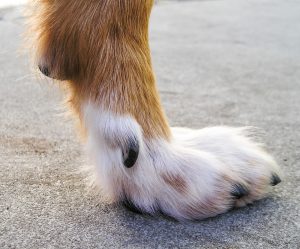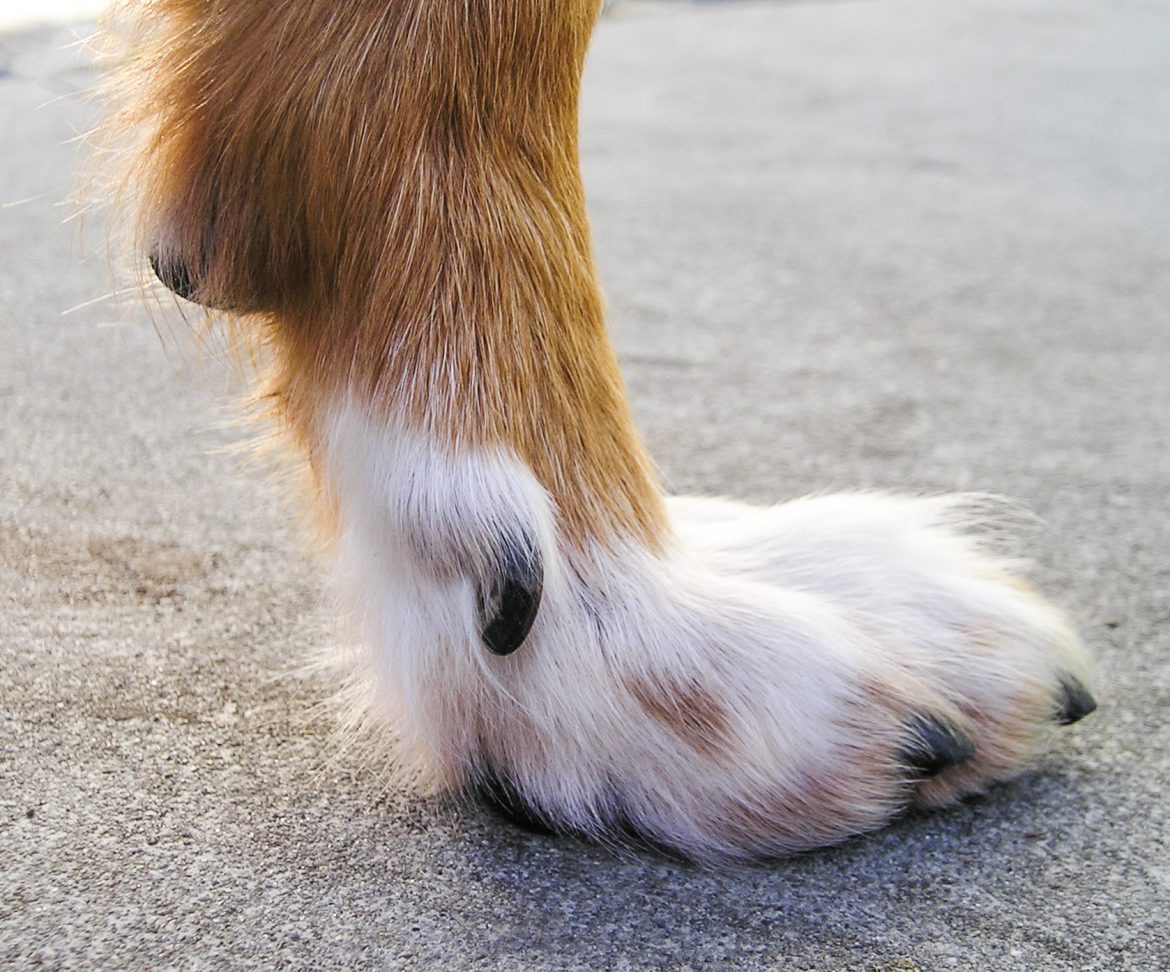Does your dog have a dew claw? Do they have a full set? If you’ve never considered it, how can you check? And more importantly, what should you do about it?
In this article, we’re going to demystify the dew claw. We’ll talk about its functions, its drawbacks, and a few different ideas on how to deal with this little digit.
Let’s dig in and learn about the dew claw!

What is a dew claw?
Dew claws are essentially the thumbs on your pup’s paws. They are located on the inner portion of your dog’s foot, slightly higher than the other claws.
In some cases, generally in the front paws, dew claws firmly attached by tendons and ligaments to the bone structure of the rest of the paw. Other times, typically on the back paws, dew claws are attached rather weakly by skin and tissue.
It’s possible for a dog to be born with only the front dew claws (most common), dew claws in the front and back (less common), and in rare cases, with double dew claws in the back. There should really be a competition for dogs born with the most dew claws!
Like the other claws on your dog’s foot, it’s completely normal for the dew claw to have its own paw pad. But, it’s often tiny enough to be hidden by your pup’s fur.
What is the function of a dew claw?
Does the dew claw have a purpose? Or is this dandling digit a vestige of the past?
As it turns out, a little bit of both. Nowadays, your pup probably doesn’t rely on their dew claws as much as they once did. But they can still be quite useful.
Most importantly, your dog’s dew claw gives them an extra bit of grip. It may seem to dangle uselessly when your dog is standing still. But, when they’re running, it does make contact with the ground. This allows your dog to be more agile and stable, especially on slippery or uneven terrain. The faster your pupper goes, the more that dew claw can keep them from misstepping or falling.
Dew claws also come in handy in dangerous situations. A dog that has found itself in a lake or river with steep or slippery banks can better pull themselves out with the help of their dew claws. The same is true for getting over fallen logs, boulders, or other tricky terrain.
Finally, dew claws are handy little tools for holding onto bones and sticks and other chewable objects. If your pupper has a strong pair of dew claws, you’ll likely see them putting those doggy claws to work while they slobber all over their favourite chew toy.
Needless to say, your dog probably relied on their dew claws much more when they were running around in the wild or living on farms. For your average family pup who’s more likely to walk regularly with their local Pet Sitter than look after a herd of sheep? The dew claws aren’t a huge advantage.
Are dew claws dangerous?
Now, there’s a lot of debate about whether dew claws pose a health risk for your dog. After all, they can sometimes get caught during play or exercise, especially for dogs whose dew claws are a bit weak or awkwardly positioned.
These claws also don’t get worn down by walking as quickly as your dog’s other claws. So, they need to be trimmed more often to make sure they’re not uncomfortable or ingrown.
But, there is some evidence to show that removing a dog’s front dew claws can lead to injury as a result of reduced stability. For herding dogs like Border Collies, then, the advantage of stable footing might outweigh the risk of a dew claw being snagged.
For the average Dog Owner, dew claws aren’t something to worry about unnecessarily. There is a small chance that they’ll get injured and they may need extra grooming care, but many dogs bounce around with dew claws their whole life without much of a fuss.
Why remove a dew claw?
In some cases, the practice of dew claw removal harks back to a long history of a dog’s working conditions. Hunting dogs, for example, tend to get into some thick underbrush, where their dew claws are more likely to get snagged. And for Dog Owners in more rural areas, the procedure is more likely to be common practice.
At the same time, the removal of dew claws can be common with show ring dogs. Most kennel clubs won’t dock points for a dog that has their dew claws. But they aren’t against dew claw removal as a practice, either.
In both cases, the procedure is typically done when the dogs are puppies and before the feature has had time to develop fully. This will ensure that the dog doesn’t experience pain from the surgery, and that the muscles in their legs can grow normally without the dew claw.
Other reasons why a veterinarian may suggest dew claw removal is if the feature poses a consistent issue for the dog. No matter what the reason is to remove a dew claw, the procedure should always be performed by a veterinarian.
How to keep dew claws safe if they’re not removed
It doesn’t take much maintenance to keep dew claws in good condition. And you can add just a few steps to your normal grooming routine:
- Trim them regularly. Exactly how often you clip your dog’s nails will depend on how quickly they grow. But a good rule of thumb (or should we say rule of dew claw) is about once every two to four weeks. You’ll certainly want to trim it before the nail starts to curl towards the paw pad.
- Be aware of dew claw discomfort. If your pup snags their dew claw while they’re playing at the dog park or chasing after a ball in the bushes, you might not notice immediately. But, your pup might start licking or chewing at the area. Take a look at the dew claw and contact your vet if there’s a sign of injury.
- If your dog wears booties, make sure they’re dew claw-friendly. Puppers who wear exercise booties can sometimes experience chafing or other irritation around their dew claws. It can help to tape it down or place a doggy sock over the dew claw to keep it secure. Remember that dogs sweat through their paw pads, so it will be important to clean the area after removing the booties.
What did you discover about the dew claw?
Overall, the doggy dew claw is an interesting piece of canine evolution. And, whether your pupper has them or not, you now know all about this little digit.
The question is, will you be keeping an eye out for the rare case of double dew claw the next time you’re at the dog park?

